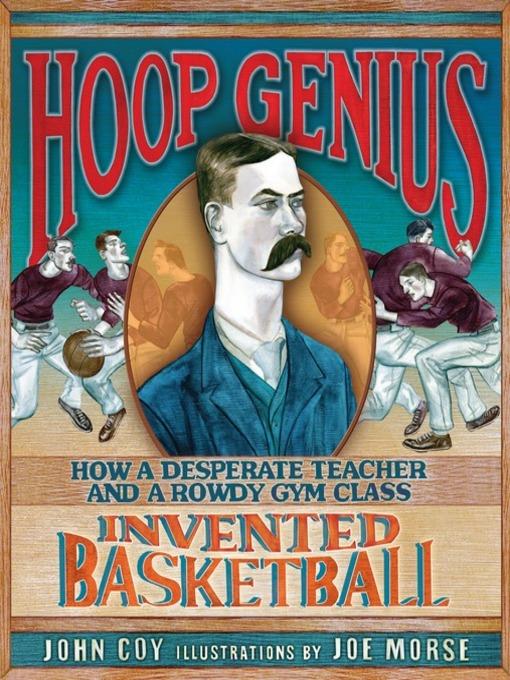
Hoop Genius
How a Desperate Teacher and a Rowdy Gym Class Invented Basketball
فرمت کتاب
ebook
تاریخ انتشار
2014
Lexile Score
880
Reading Level
3-5
ATOS
4.6
Interest Level
K-3(LG)
نویسنده
Joe Morseشابک
9780761387237
کتاب های مرتبط
- اطلاعات
- نقد و بررسی
- دیدگاه کاربران
نقد و بررسی

February 11, 2013
Coy (the 4 for 4 series) tells the story of basketball’s founding in 1891 directly and succinctly. Young teacher James Naismith takes over a gym class of unruly young men. When other organized games produce walking wounded, “Naismith felt like giving up but couldn’t. The boys in the class reminded him of how he’d been at their age—energetic, impatient, and eager for something exciting.” Thirteen rules, a ball, and two peach baskets later, he develops a new game that demands accuracy while tempering aggressiveness. The story’s dynamism comes from Morse’s (Play Ball, Jackie!) stylized prints, whose posterlike quality is amplified by the limited palette of blue, brown, and maroon. Lanky limbs stretch dramatically across the pages, a visual foil to Coy’s spare storytelling style. While it’s slightly disconcerting to have the students referred to as “boys” when they appear as mustached young adults, their grimacing, chiseled features in motion are attention- grabbing. This lively glimpse into the beginnings of a hugely popular sport concludes with a short author’s note and bibliography. Ages 7–11. Author’s agent: Transatlantic Literary Agency. Illustrator’s agent: Heflin Reps.

March 1, 2013
Gr 1-3-In 1891, a teacher named James Naismith invented a game that was destined to become a national sensation. The boys' gym class at his school was particularly rowdy. He needed to find an indoor activity for the energetic lads that was fun, but not too rough. Inspired by a favorite childhood game, he stayed up late one night typing the rules of his new game. With a soccer ball, two peach baskets, and the rules tacked to the bulletin board, Naismith introduced his idea to the unruly class the next day. In that first game, only one basket was scored, but the boys were captivated. During Christmas vacation, they taught their friends how to play basketball and soon its popularity spread across the country. Even women formed a team. By 1936, basketball became a recognized Olympic sport and Naismith was honored at the opening ceremonies. Morse's energetic illustrations add an old-fashioned charm to the narrative. Readers will also want to examine the endpapers, a reproduction of the original rules of the game typed by Naismith. This entertaining and informative story will delight young sports fans.-Linda L. Walkins, Saint Joseph Preparatory High School, Boston, MA
Copyright 2013 School Library Journal, LLC Used with permission.

February 1, 2013
This picture-book basketball history spotlights how James Naismith came to invent the game now played around the world. Stylized illustrations in tones resembling tinted sepia prints depict riotous students playing indoor sports, accumulating more injuries with each page turn. The text asserts that they "had already forced two teachers to quit. / [Naismith] didn't want to, but nobody else would teach that class," setting the scene for Naismith's realization, seemingly self-prompted, that a new game with less physical contact was needed. Memories of childhood games lead to his eureka moment. However, with so little context provided, readers may question where this class was being held, why the "boys" look like men the same age as Naismith and how Naismith came to work with them. The original rules of "Basket Ball" are printed on the end pages, and the players' enthusiasm for the game is evident, but details such as court dimensions and where baskets were hung are not included. Perhaps in a nod to Title IX, youngsters learn that Naismith taught the game to a group of women, and the book ends with a note about the game's inclusion in the 1936 Olympics. Given its limited scope, both hoops fans--who will be familiar with this story from rule and sports-history books--and newbies may feel this book has left them circling the rim. (author's note; selected bibliography) (Informational picture book. 5-10)
COPYRIGHT(2013) Kirkus Reviews, ALL RIGHTS RESERVED.

February 1, 2013
Grades 2-4 In December 1891, James Naismith, a physical education teacher in Springfield, Massachusetts, was looking for a way to channel the energy, impatience, and eagerness of his male students. Recalling a game he knew as a child, called Duck on a Rock, he invented a lesson using an old soccer ball and two peach baskets to minimize contact injuries and emphasize finesse and accuracy over brute strength. Pretty quickly, Naismith knew he was onto something: though only one basket was scored the entire first game, his students didn't want to leave gym class. Over Christmas vacation, the kids taught the game to friends, and soon, a group of women teachers from a nearby school dropped by to learn the new sport. By 1936, Naismith's game had become an Olympic event. Well researched with material artifacts and primary sources, this historical account is boosted significantly by blocky, muscular illustrations in muted tones that effortlessly mix tongue-in-cheek whimsy with serious action. Anybody who plays the game or watches it ought to find this pretty engrossing.(Reprinted with permission of Booklist, copyright 2013, American Library Association.)

























دیدگاه کاربران